Hey there, vintage lovers! I have a confession to make.
One of my favorite “vintage discoveries” is when I find a piece of DEADSTOCK VINTAGE.
It’s like finding a diamond amongst the jewels: I’m already so satisfied with the vintage finds I’m discovering, but then I see a shimmer that truly makes my heart beat faster — a piece of vintage with the original tags.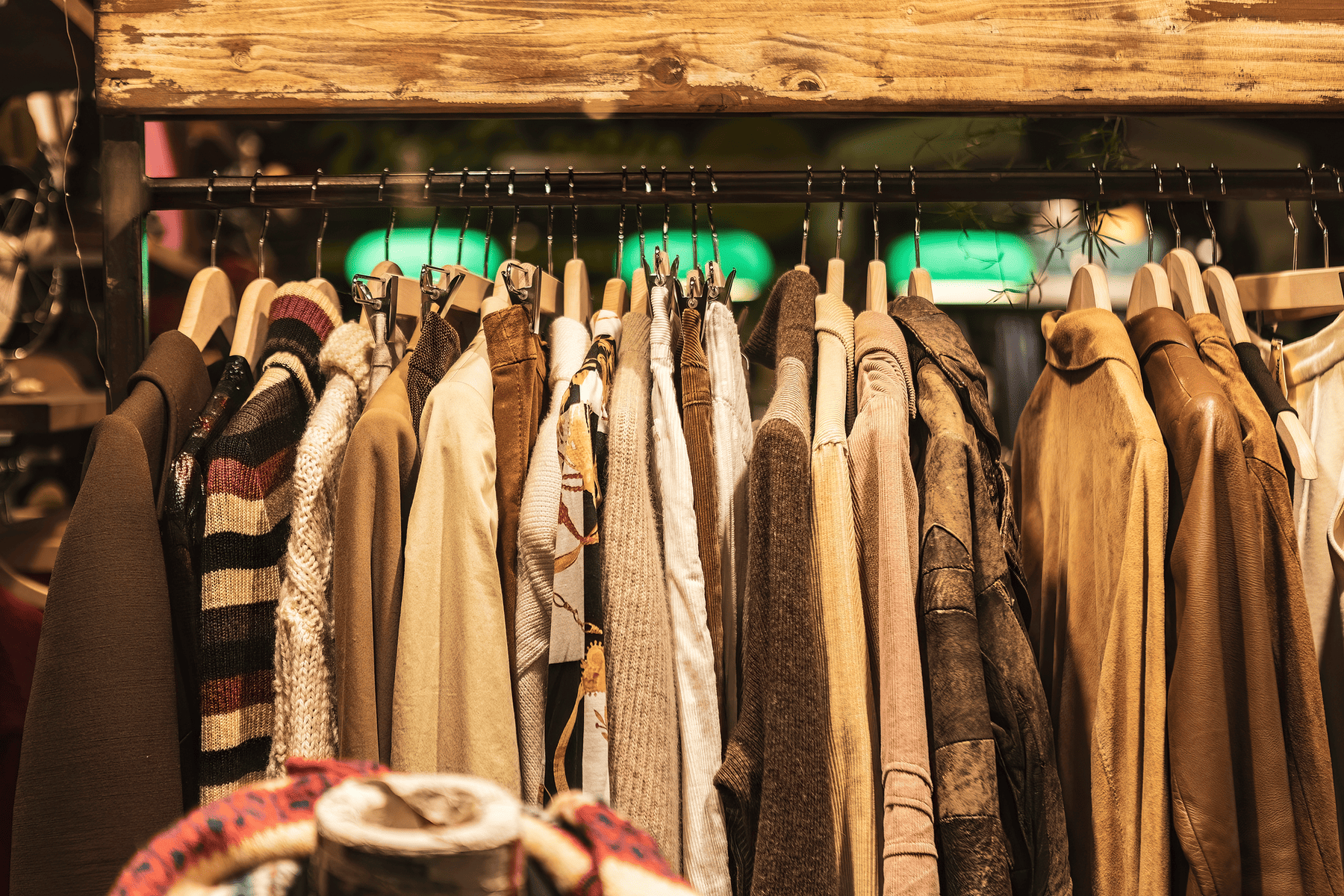
In an age of fleeting trends, owning a piece of unworn history is a chance to stand out with distinctive style. You get to experience the thrill of discovering pieces that transcend time, each with a story to tell.
Vintage clothes help you explore the past, make informed choices, and enrich your wardrobe with timeless pieces that redefine fashion. Uncover the allure of deadstock vintage and embark on a stylish journey into the past.
Join me as I delve into vintage authenticity, charm, and perks. Learn to distinguish and invest wisely in this unique market with environmental advantages.
What Exactly Is Deadstock Vintage?

When you engage in the business of thrifting or shopping vintage and you find a piece of vintage clothing (at least 20 years old, or roughly from the early ’90s and earlier) with its original tags still on, you’ve encountered what the industry refers to as deadstock.
But where does the term come from?
The term deadstock (often mistakenly referred to as dead stock) refers to pieces that have “passed away” [i.e. died] from the original stock where they previously existed [i.e. lived] in a store.
The piece of vintage clothing didn’t sell from that shop for whatever reason.
Perhaps it was a piece of clothing from the store/boutique/department store chain that went bankrupt and its remaining inventory found its way to a thrift market or the hands of a vintage boutique owner; no matter the retail location.
Deadstock vs. Dead stock
Dead stock refers to inventory (not necessarily vintage) that stores have discontinued. It’s like when they stop making or selling a certain item. On the other hand, deadstock means vintage items that are still brand new, with tags and everything. Sometimes people mix up these words and use them in the wrong way, which can be confusing.
Here’s a hint: Online marketplaces are also a part of the deadstock business.
How Much Inventory Does It Take Up?
It’s true – deadstock takes up valuable warehouse space or interferes with inventory levels, sucking business profit. Eliminating deadstock is what a majority of companies are striving for, while meeting regular customer demand and profit margins at the same time.
But is deadstock bad? Not necessarily!
Selling products doesn’t have to end here. There is more companies can do other than regular sales, beyond the items initial company, making it more than just excess stock.
Other Terms You Can Stumble Upon
“Deadstock” vintage carries a slight negative connotation because of the word “dead.”
That’s why many vintage boutique owners have decided to call it “livestock” because by selling it on their racks and shelves again, they are essentially breathing new life into a piece that is ready to sell.
Other vintage dealers may refer to dead/livestock as “New Old Vintage” or “Never Off the Shelves,” abbreviated with the acronym NOS.
The Allure of Deadstock

In an age of fast fashion and fleeting trends, deadstock vintage stands as a testament to the enduring appeal of timeless elegance – not only regarding the clothing itself, but also in the stories it can tell.
Just imagine possessing a piece of untouched history, a fashion relic that’s frozen in time.
Let’s be honest for a second – today’s quality of clothes cannot compare to the craftmanship of deadstock items. These items were made during a time when when garments were cherished, with every stitch boasting dedication and skill, far different than most items selling today.
How Is Deadstock Different From Regular Vintage?
That’s the real question.
Deadstock stands apart from regular vintage items due to its untouched and pristine condition. Unlike typical vintage pieces that have been worn, and experienced the passage of time, deadstock items have never been sold or used, remaining in their original condition.
This quality gives them a clear historical importance, providing a direct connection to the past while still being in unused condition. The appeal of deadstock is in having the chance to possess a piece of history that has remained untouched since its original production.
Regular vintage items, on the other hand, have stories to tell through signs of wear and aging, reflecting the passage of time and the experiences of their previous owners. The uniqueness of deadstock vintage arises from the ability to experience the past in a pristine state, providing the consumer with a truly exceptional connection to an era that has passed.
Advantages of Investing in Deadstock Vintage
Garments that are readily available today might come at a lower cost, yet their benefits pale in comparison to the numerous merits of deadstock merchandise. Investing in deadstock vintage articles is truly worthwhile. Such items serve as representative artifacts of specific eras, forging a distinctive link with the past.
Furthermore, deadstock items remain largely untouched, frequently originating from limited production batches. This scarcity in product availability can contribute to their appreciating value over time, especially if these pieces become coveted by particular consumer segments, notably collectors. The uniqueness of deadstock merchandise sets it apart from contemporary attire, presenting an opportunity for heightened creative expression in personal style.
Should You Sell DeadStock?
If you are strategic in your selections, investing in deadstock vintage items can potentially lead to significant financial gains.
As the supply of these items dwindles over time, their value may appreciate, allowing you to sell them to another consumer for a higher price in the future.
An Environmentally Friendly Practice
Buying deadstock is also very good for the environment!
By opting for deadstock items, you’re engaging in a practice of sustainability and conscious consumerism.
In a world where fast fashion and disposable trends often dominate, choosing deadstock means repurposing existing items, thereby reducing the demand for new production and minimizing the strain on precious resources, as well as utilizing something that would otherwise stay in a warehouse before getting thrown away after a given period due to poor sales.
It’s like you’re saving the planet.
Challenges in the Deadstock Vintage Market
Some of the main challenges in this field could be ensuring authenticity, as some items could be mislabeled as deadstock.
Ensuring that items are truly vintage and have never been used requires careful research and expertise.
Quality control could also be a challenge. Typically, these items tend to be in pretty good condition, but you’ve got to factor in that they might have been stored away in some warehouse for years.
This problem alone can open the door to a range of potential problems such as deterioration, discoloration, or even unexpected damage that might have cropped up over time due to their hibernation, interfering with its ability to sell.
It’s like they’ve been in a fashion time capsule, waiting to tell their tales – which can be cool, but also something to be aware of when you’re diving into the world of deadstock vintage.
Is There a Future for Deadstock Vintage?
My honest prediction is that “deadstock vintage” will be harder and harder to come by in the future because certain companies, more precisely “second season chains”, (TJ Maxx, Marshal’s, Ross, Filene’s Basement, Loehmans, etc.) are making it more difficult for inventory of today to exist unworn without purchase.
To prevent the accumulation of unsold items in storage, the duration required for them to be recognized as officially “vintage” should be considered.
So, H&M, Forever 21, Zara, will not be taking up valuable warehouse space for 50 years as excess inventory unable to sell and interfering with cash flow, only to be discovered in 2061 by a vintage lover and sold as deadstock from 2011.
Rather, the pieces from mainstream stores will be sold to consumers out of season at stores like Marshals and during regular clearance sales when the premium price drops.
This helps certain companies avoid deadstock, before it can become deadstock.
How to Authenticate and Care for Deadstock Vintage
When shopping vintage online, use “deadstock” in your search keywords. I’ve noticed many sports fans search, for example: “deadstock snapbacks” on Google.
Sneaker enthusiasts search for “deadstock sneakers.” Then, there’s “deadstock sunglasses” on Ebay, Etsy, Market Publique and other online vintage marketplaces.
If your search results don’t satisfy your deadstock shopping needs, then try this example: “livestock” or the abbreviation “NOS,”.
For instance, I just search for “NOS vintage” on Etsy and yielded these search results. The same should work for Ebay and such.
Be Wary of Scams!
If it seems too good to be true, maybe it is.
Be wary of businesses selling deadstock items at unusually low prices, as they could be misrepresented, and you could be at risk of wasting your money.
What To Look Out for When Buying DeadStock Vintage?
When engaging in the pursuit of purchasing deadstock items, arming yourself with knowledge becomes an indispensable tool to ensure that each investment is a well-informed decision.
To embark on this journey, a comprehensive understanding of the brands, historical costs, unique styles, and the specific time periods associated with the vintage pieces you’re eyeing is paramount.
This foundation serves as a safeguard against all ill-advised expenditures.
Trustworthiness and reputation should serve as guiding principles when identifying potential sellers. These sources can encompass the realm of physical vintage boutiques, online platforms, or even individual sellers.
Before committing financial resources, it is paramount to thoroughly acquaint yourself with the background of these suppliers.
This entails delving into reviews, ratings, and testimonials, or even seeking recommendations from knowledgeable sources. Transparent communication regarding pricing structures is a litmus test for the integrity of these sellers, ensuring that your hard-earned finances are invested judiciously.
Where Do We Draw the Line?
The term “deadstock” should apply only to the pieces which were never sold straight from a store.
As a society and culture we have become very consuming hungry individuals.
Instead of spending our hard-earned money on only what we truly need, we decide to spend it on what we want instead — and we do that more often than not.
- How many of you have something “new” hanging in your closet right now? You haven’t had the chance to weat it yet, but it cost serious money?!
- How many of you have been shopping your local thrift store to find a whole line from H&M new with tags?
I’m not sure what this “unworn merchandise with tags” should be called — because it’s not vintage.
Taking Care of Deadstock
Caring for your cherished deadstock acquisitions demands a concerted effort to preserve their integrity over time. Upon obtaining these prized possessions, a paramount responsibility emerges—to ensure their longevity through diligent upkeep.
The initial step involves creating a conducive environment for your vintage items. This entails storing them in a setting that is cool, dry, and devoid of direct exposure to light. Shielding these treasures from the adverse effects of sunlight, abrupt temperature shifts, and excess humidity is vital.
By doing so, you effectively thwart the potential hazards that these external factors pose to the intricate fabrics, colors, and materials that constitute your collectibles. By preventing fading, warping, or gradual deterioration, you reaffirm your commitment to safeguarding their historical value.
Should the necessity for cleaning arise, diligent research is indispensable.
Delve into the nuances of appropriate cleaning techniques, considering the specific material and the era to which the item belongs. This ensures that any cleansing undertaken is executed with meticulous precision, safeguarding the item’s structural integrity and aesthetic allure. Through these conscientious measures, you not only honor the historical significance of your deadstock treasures but also fortify their legacy for generations to come.
Examples of Deadstock Vintage
Finally, it’s time to see deadstock, “in person.”
Keep scrolling to see examples of deadstock vintage I’ve captured along my thrift and vintage journeys.
The tag design, typography and language – not to mention price – make me smile so much that I even wrote this post on how to identify vintage in a thrift store with tags & labels.
Check it out for more vintage shopping know-how!
Example no. 1:

Example no. 2:
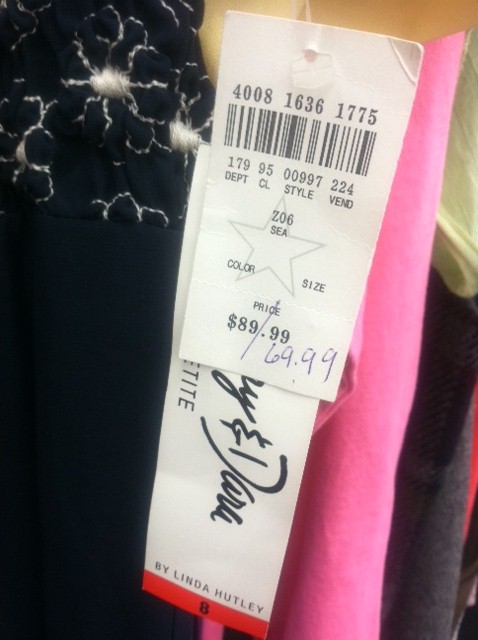
Example no. 3:
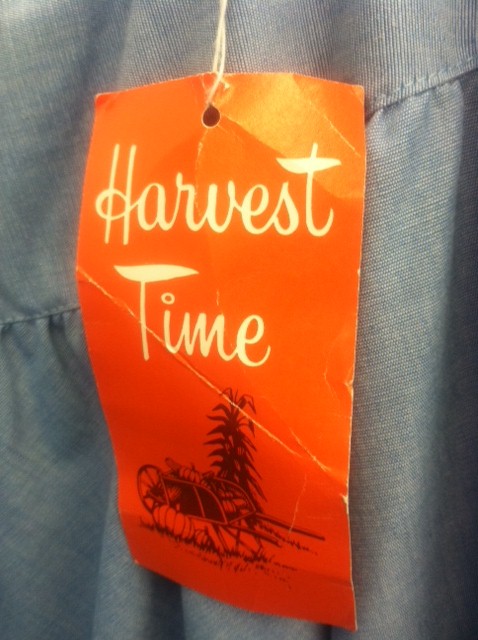
Example no. 4:
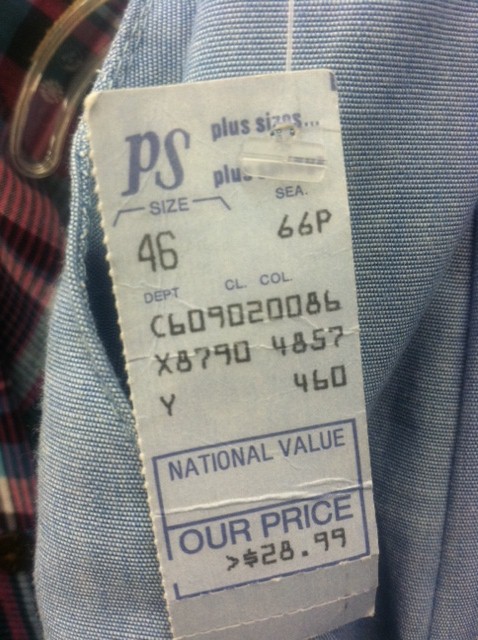
Example no. 5:
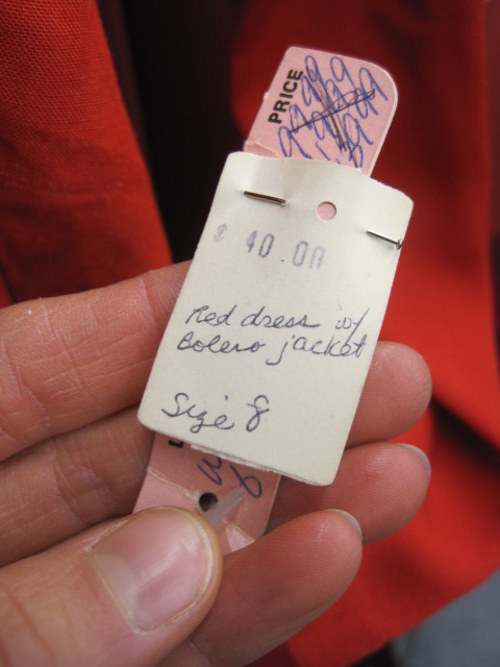
Example no. 6:

Example no. 7:
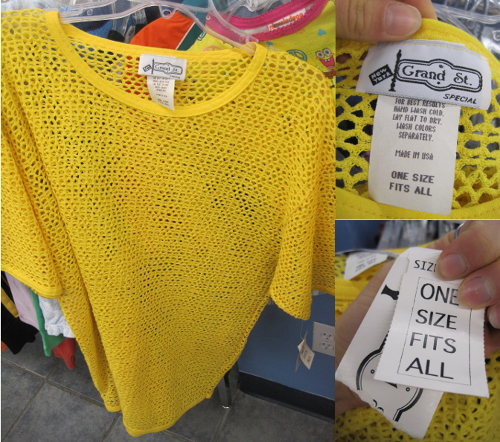
You Can Even Buy Deadstock Fragrances
Deadstock vintage line of perfumes and colognes refer to fragrances produced years or decades ago and have never been used or opened, or even sold.
These fragrances can have significant value for collectors and perfume enthusiasts, as they offer a glimpse into the past and a chance to experience scents that are no longer in demand.
Vintage or Modern Fragrances?
Vintage fragrances often differ from modern fragrances in both composition and performance.
Many vintage fragrances use high-quality natural ingredients, creating more complex and long-lasting scents. On the other hand, modern fragrances often rely on synthetic ingredients and may be designed to have a more mass-market appeal.
Despite the appeal of vintage fragrances, many modern fragrances have gained a strong following. For example, Dolce & Gabbana Light Blue Perfume for Women is a popular fragrance that combines citrus and floral notes to create a fresh and bright scent.
“Juliette Has a Gun” is another modern fragrance brand that has gained popularity for its edgy and unconventional line of scents.
YSL is a classic fragrance brand that has been producing fragrances for decades. Some of their most popular scents include Opium, a spicy and exotic fragrance, and Black Opium, a modern and feminine scent with notes of coffee and vanilla.
While vintage fragrances can offer a unique and valuable experience, modern fragrances remain popular for their accessibility and mass-market appeal. A wide range of fragrance options is available today, from classic brands like YSL to newer, more experimental brands like Juliette Has a Gun.
The Final Verdict
Here it is, a comprehensive insight into the world of deadstock vintage, summing up the charm and challenges of selling, buying, and accumulating deadstock, and why it continues to captivate consumers, collectors and fashion enthusiasts alike, making it a worthy investment.
Think of it as a journey through time for your wardrobe, an opportunity to possess a tangible slice of history, and an undeniable method to captivate attention with your truly unique fashion sense.
Embrace the power of these remarkable finds and make a statement that’s bound to leave an impression.
Your fashion adventure awaits!

OMG. I have a deadstock vintage Lanvin dress from the 60s I’m guessing, plus a vintage deadstock Carla Marchi bag, from maybe the 80s? I could send you pics if you would like!
xoxo
Lia
i always love finding deadstock items! i think it’s the tags… who knows :)
Great piece! I really learned a lot!
Yay…I learned a new term today. How fun to find an original tag on a retro piece….I can see where the value would definitely go up! Love your blog!
NOS stands for New Old Stock.
Love your blog very insightful and will be put to good use. My store in on Facebook it’s a first and new swap meet in southernmost oregon called Siutgern Oregon Buy N Sell. Ceck it out!
Dear Sammy D,
Thank you for your explanation of deadstock. Often times I see in on-line auctions that a seller has listed something as NOS and they are selling numerous item from one company.
My question; is it possible to but new old stock directly from manufacturers who have gone out of business?
It’s driving me crazy cuz I want to cash in on this trend!
My mother started buying clothes in the 1950-60’s. She’s a clothes horse, and she takes such good care of her stuff that it literally looks like brand new. I have a huge storage unit on our property full of clothes, shoes, shirts, jackets, full length coats, hand bags, and every kind of accessory you can possibly imagine. But I don’t know what to do with all this crap. I’m not a big clothing person, levi’s, tee shirts, and hiking/fishing boots are what I wear. I hate shopping. She could spend hours in one shop, and it made me nuts. I never went shopping with her. But she has excellent taste and I hate to just take it to the dump because I know it’s probably worth a lot of money. I just don’t know what to do with it. If anyone knows people who handle this sort of thing for a fee? Please let me know.